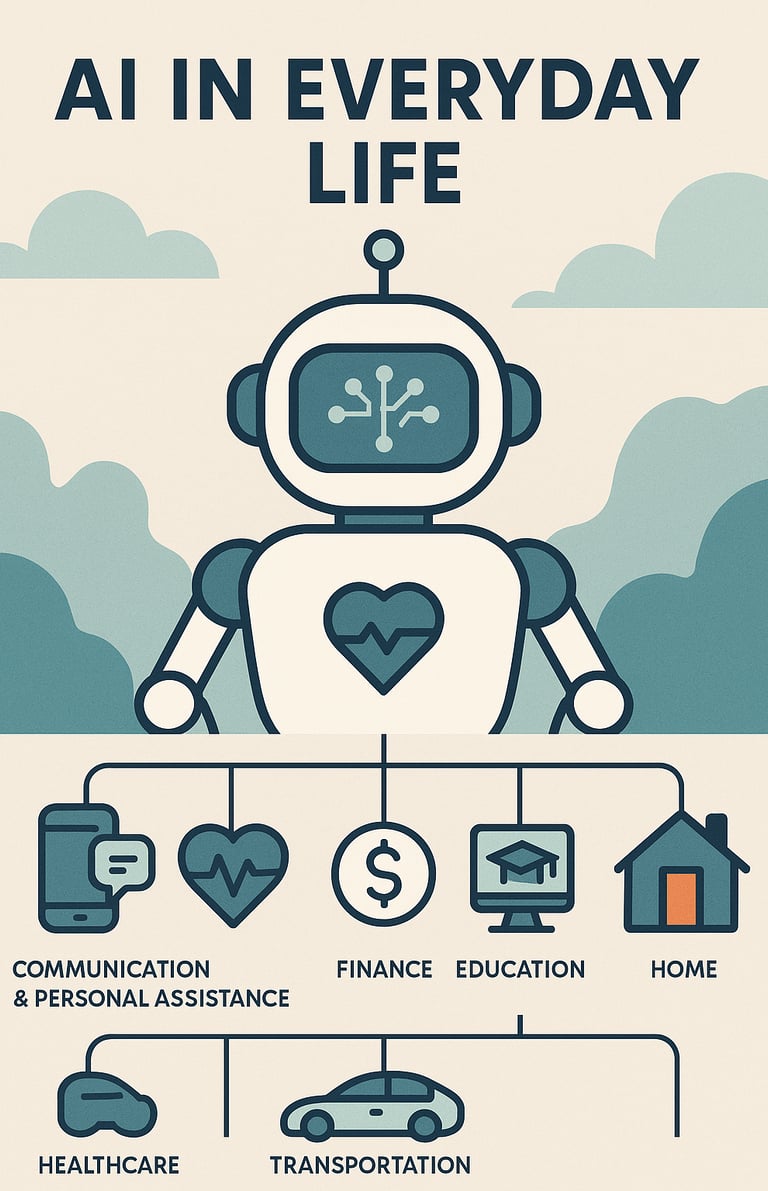AI in Everyday Life: How Artificial Intelligence Is Reshaping the World Around Us
AI in Everyday Life: How Artificial Intelligence Is Reshaping the World Around Us
TECHNOLOGY
MrTruth.Tv
9/29/20254 min read
Introduction: From Science Fiction to Daily Reality
Not long ago, artificial intelligence (AI) was mostly a futuristic concept seen in science-fiction films and academic papers. Today, it’s a quiet but constant presence in our daily routines—suggesting songs on Spotify, detecting credit card fraud, assisting doctors in diagnosing diseases, and even helping farmers predict crop yields.
According to a 2024 report from McKinsey & Company (source), 72% of surveyed organizations use AI in at least one business function, a sharp rise from just 20% in 2017. As computational power grows and algorithms become more sophisticated, AI’s influence on everyday life is expanding at a breathtaking pace.
This article explores how AI now permeates communication, healthcare, finance, transportation, education, entertainment, and more—while also examining the ethical considerations and future trends.
1. AI in Communication and Personal Assistance
Smart Assistants and Conversational AI
Voice-activated assistants such as Amazon’s Alexa, Google Assistant, and Apple’s Siri demonstrate AI’s ability to process natural language and provide immediate responses. These systems rely on natural language processing (NLP) to interpret speech, respond to commands, and even anticipate user needs.
The success of large language models (LLMs) like OpenAI’s GPT-5 has further advanced conversational AI. These models can summarize emails, draft messages, or even write computer code, transforming how individuals and businesses communicate (OpenAI Research).
Real-Time Translation
AI-driven translation tools, such as Google Translate and DeepL, employ neural machine translation to break down language barriers. According to a Stanford University study (source, 2023), machine translation accuracy has improved by more than 60% over the past decade, enabling more seamless international communication for travelers, businesses, and multicultural families.
2. AI in Healthcare
Early Diagnosis and Personalized Medicine
AI systems can analyze vast amounts of patient data—from medical imaging to genetic information—to identify diseases earlier than human clinicians might. For example, DeepMind’s AI achieved expert-level accuracy in detecting over 50 eye diseases using retinal scans.
Precision medicine is another major frontier. Algorithms analyze a patient’s genetic profile to recommend individualized treatments. This approach is transforming cancer therapy and rare-disease management, leading to better outcomes and fewer side effects.
Hospital Operations and Virtual Care
AI streamlines hospital workflows, predicting patient admission rates and optimizing staff schedules. Meanwhile, AI-driven telemedicine platforms like Babylon Health and Ada Health provide initial assessments and guidance, improving access to care in underserved areas.
3. AI in Finance
Fraud Detection and Risk Management
Financial institutions deploy AI to detect fraudulent transactions in real time. Machine-learning models analyze spending patterns and flag anomalies, significantly reducing losses from fraud. JPMorgan Chase, for instance, uses AI to monitor billions of transactions daily (JPMorgan AI Report).
Algorithmic Trading
AI-powered trading platforms evaluate market data and execute trades at lightning speed. While algorithmic trading raises concerns about market volatility, it has also improved liquidity and reduced transaction costs for investors (Investopedia).
4. AI in Transportation
Self-Driving Vehicles
Perhaps the most visible example of AI in transportation is autonomous vehicles. Companies such as Tesla, Waymo, and Cruise rely on deep-learning algorithms to process sensor data, detect obstacles, and make split-second driving decisions.
The U.S. National Highway Traffic Safety Administration (NHTSA) projects that AI-driven vehicles could reduce traffic accidents—94% of which are caused by human error (NHTSA Data).
Logistics and Delivery
AI also powers route optimization for logistics companies like UPS and FedEx, reducing fuel consumption and delivery times. During the COVID-19 pandemic, autonomous delivery robots gained traction in cities around the world (MIT Technology Review).
5. AI in Education
Personalized Learning
Adaptive learning platforms such as Khan Academy’s Khanmigo and Duolingo leverage AI to tailor content to individual student needs. They adjust difficulty levels in real time, improving learning efficiency (EdTech Magazine).
Automated Administrative Tasks
AI reduces educators’ administrative burden by grading assignments, tracking attendance, and analyzing student performance data. According to a UNESCO report (source), AI-driven tools help teachers focus more on mentoring and less on paperwork.
6. AI in Entertainment and Media
Content Recommendation
Streaming platforms like Netflix, Spotify, and YouTube use AI recommendation engines to analyze user preferences and viewing habits. These algorithms are responsible for more than 80% of content consumed on Netflix, according to a 2024 internal report cited by Wired (Wired).
Creative Applications
AI-generated art and music are now mainstream. Programs such as DALL·E, Runway, and AIVA can compose music, generate photorealistic images, and even create video clips. While some artists view AI as a threat, others embrace it as a powerful collaborative tool.
7. AI in the Home and Workplace
Smart Homes
From thermostats like Google Nest to security systems such as Ring, AI-enabled devices learn user preferences and automate energy management, lighting, and security. This reduces energy costs and enhances convenience.
Workplace Automation
AI-powered analytics tools like Tableau and Microsoft Power BI enable data-driven decision-making. Meanwhile, AI chatbots handle customer service inquiries, allowing human agents to focus on complex issues.
8. Ethical Considerations and Challenges
While AI offers enormous benefits, it raises pressing ethical and societal concerns.
Privacy and Data Security
AI systems require massive datasets, often containing personal information. Data breaches or misuse can have serious consequences. Regulatory frameworks like the EU’s General Data Protection Regulation (GDPR) and the proposed U.S. AI Bill of Rights (White House OSTP) aim to protect user privacy.
Bias and Fairness
AI models can inadvertently perpetuate social biases if trained on skewed datasets. Examples include biased facial-recognition systems and discriminatory lending practices. Addressing these issues requires rigorous auditing and transparent algorithm design (AI Now Institute).
Job Displacement
Automation threatens certain job categories, from manufacturing to administrative roles. However, it also creates new opportunities in AI development, data analysis, and human-machine collaboration. The World Economic Forum projects that AI will displace 85 million jobs by 2025 but create 97 million new ones (WEF Future of Jobs Report).
9. The Future of AI in Everyday Life
Experts predict that AI will soon become even more embedded in daily living:
Healthcare: AI will assist in drug discovery and robotic surgery.
Climate Action: Predictive AI models will enhance renewable energy management and climate forecasting.
Human-AI Collaboration: “Co-pilot” systems will help workers in engineering, law, and creative fields.
Emerging trends such as explainable AI (XAI)—which makes decision-making processes more transparent—will be key to building public trust.
Conclusion: Living with AI
Artificial intelligence is no longer a distant vision of the future. It’s the unseen force helping you choose a playlist, navigate rush-hour traffic, detect fraudulent charges, and even monitor your health.
The question is no longer if AI will shape everyday life—it already has. The challenge now lies in ensuring that this powerful technology evolves responsibly, balancing innovation with ethics, privacy, and human oversight.
As society continues to adapt, one thing is certain: AI will remain a central player in the story of our everyday lives.
Key Sources & Recommended Backlinks



